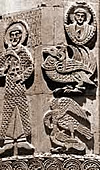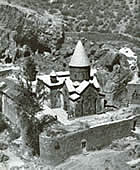Glossary (Faustus the Byzantine – Gregory Aknertsi)
Faustus the Byzantine
Armenian historian of the 5th century. He wrote the 3 volume History, of which the first 2 are lost. He described in details the reign of Arshak II and Papes I.
Fourth Armenia
(Chorord Hayk) One of 15 historical provinces or ashkhars (“worlds”) of the Greater Armenia, the Forth Armenia consisted of 10 cantons: Khordzian, Hashtyank, Paghnatun, Balahovit, Mets Tsopk, Angueghtun, Andzit, Pokr Tsopk (Shahuniats Tsopk), Deguik and Gorek.
Frik
(1230-1300) Armenian poet, native of Siunik. He was imprisoned by Mongols, and then fled to Cilica where he wrote poetry, mostly love lyrics.
Gagik Artsruni
 Relief of Gagik Artsruni, in the Church of Holy Cross.Armenian prince, maternal nephew of Sembat I and founder of Artsruni royal dynasty that ruled Vaspurakan from 908 to 1021. He became ruler of Vaspurakan province in 902. Ambitious and power-seeker, he betrayed Sembat I and joined his enemies Afshin and Yussouf, governors of the Caliph in Atrpatakan. In 908, he proclaimed himself King of Armenia, but his power did not extend beyond his domains in Vaspurakan. His ruling marked the heyday of the Armenian architecture. The magnificent royal palace and the Church of Holy Cross were built by the architect Manuel on the island of Akhtamar.
Relief of Gagik Artsruni, in the Church of Holy Cross.Armenian prince, maternal nephew of Sembat I and founder of Artsruni royal dynasty that ruled Vaspurakan from 908 to 1021. He became ruler of Vaspurakan province in 902. Ambitious and power-seeker, he betrayed Sembat I and joined his enemies Afshin and Yussouf, governors of the Caliph in Atrpatakan. In 908, he proclaimed himself King of Armenia, but his power did not extend beyond his domains in Vaspurakan. His ruling marked the heyday of the Armenian architecture. The magnificent royal palace and the Church of Holy Cross were built by the architect Manuel on the island of Akhtamar.
Gagik I
 Relief of Gagik I, Cathedral of St. Gregory, in Ani
Relief of Gagik I, Cathedral of St. Gregory, in Ani
King of Armenia (990-1020) of Bagratuni dynasty. He ruled in Ani. Historians attribute to him and to his wife Katramide the construction of numerous churches and monasteries. In 1000, he terminated the building of the sumptuous cathedral of Ani that was started by his brother and predecessor Sembat II.
Gagik II
King of Armenia (1041-1045). He was the last king of the Armenian Bagratuni dynasty. In 1044, the Byzantines entrapped him to Constantinople under pretext of signing a treaty of peace, and forced him to abdicate.
Gandzak
City of historical Aghuank of Eastern Armenia, Gandzak became Elizavetpol following the Russian annexation in 1804, Ganja as capital of Musavatist Azerbaijan in 1918, and Kirovabad as second large city of Soviet Azerbaijan in 1935. In 1989, the city was again renamed Ganja.
Gandzasar
 The Gandzasar Monastery
The Gandzasar Monastery
Monastery in Artsakh, in Mardakert region of the NKR, Gandzasar is an outstanding monument of the Armenian architecture. Founded in 1216, Gandzasar became an important center of the Armenian political and cultural life. During the centuries, it was residence of Catholicos of the eastern lands of Armenia.
Garni
 The Garni temple
The Garni temple
Fortress and pagan temple situated 20 km from Yerevan, Garni is mentioned by many ancient authors such as Tacite. The reconstruction of Garni in 76 is attributed to King Tiridates I. Garni is famous for its sumptuous royal palace, Roman baths and a beautiful pagan temple.
Gayane
 The Church of St.Gayane
The Church of St.Gayane
A Christian virgin nun, who was killed by order of Armenian King Tiridates the Great around 300. Together with Hripsime, she is the most famous Christian martyr in Armenia, elevated into sainthood. In 630, Catholicos Yezr built the Church of St.Gayane in the city of Vagharshapat (present Echmiadzin).
Geghart
 View of Geghart monastery
View of Geghart monastery
Monastery of 13th century located 38 km south-east of Yerevan in a scenic countryside. The main church was built in 1215. In 1282, the rock-hewn churches were carved out from a rock outcrop by order of Prince Prosh Khaghbagian and his son Papak.
Ghukasyan, Arkady
 Arkady Ghukasyan
Arkady Ghukasyan
Born in 1957. In September 1997, he was elected President of the Nagorno-Karabakh Republic. Before his election in 1993-1997, Ghukassian headed the NKR Foreign Office and represented the Nagorno-Karabakh Republic in the negotiations within the framework of the OSCE. He was reelected President of NKR in 2002 elections, and in 2007, succeeded by Bako Sahakian.
Greater Armenia
(Armenia Magna, Metz Hayk) Historical designation of the territory between River Kura on the North, Caspean Sea on the East, Western Tigris on the South and River Euphrates on the West. The complete information on the administrative division of the Greater Armenia can be found in Ananya Shirakatzi’s Geography guide, according to which the Greater Armenia consisted of 15 provinces, called worlds. Each province included a number of cantons. The 15 provinces or worlds of the Greater Armenia were: Ayrarat, Turuberan, Vaspurakan, Siunik, Higher Armenia, Forth Armenia, Aghdznik, Mokk, Korchek, Persian Armenia, Paytakaran, Artsakh, Outik, Gugark and Tayk.
Gregory Aknertsi
Armenian scholar of 13th century. His History of the Mongols is a precious source.







